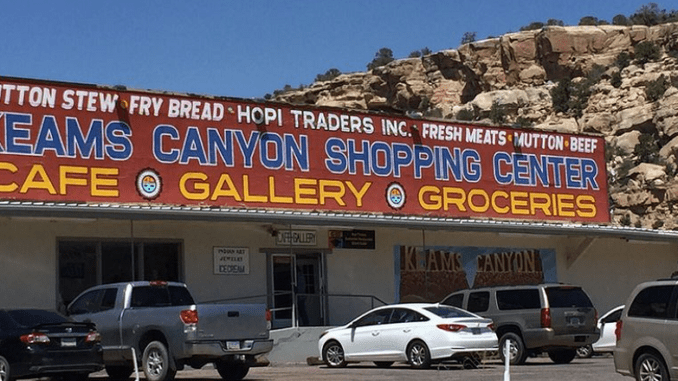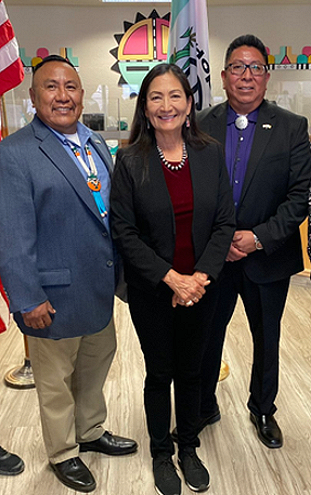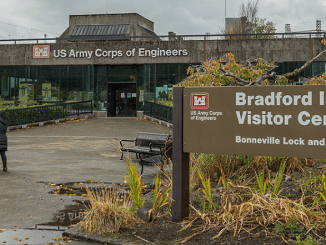
SUPAI, Arizona, May 23, 2023 (ENS) – Tribal communities in five Western states: Arizona, Idaho, Montana, South Dakota, and Washington, will receive millions from the $1.2 trillion Bipartisan Infrastructure Law, Secretary of the Interior Deb Haaland announced this week during a visit to tribes in her home state of Arizona. The law, signed by President Joe Biden in November, invests more than $13 billion directly in Tribal communities across the country, including $250 million over five years for Tribal dams and water projects.
Secretary Haaland completed her visit to Arizona today, where she met with local Tribes to detail how funding from President Biden’s Investing in America agenda is helping support Indigenous communities in securing clean water and reliable infrastructure.
“In response to chronically underfunded infrastructure in Tribal communities, the President’s Investing in America agenda is deploying record investments to provide modern wastewater and sanitation systems, clean drinking water, and reliable and affordable electricity,” said Secretary Haaland, who is a member of the Laguna Pueblo tribe, located in Winslow, Arizona.
This meeting followed her weekend engagement with Tribal leaders of the Grand Canyon Tribal Coalition, local elected officials, and community members to learn about their vision for conserving the natural and cultural resources in the greater Grand Canyon watershed.
On Sunday, Secretary Haaland met with leaders from the Hopi Tribe. There, she announced $6.6 million in Bipartisan Infrastructure Law funding to replace the existing water distribution system in the community of Keams Canyon to ensure that residents can receive safe, arsenic-free water.

The expansion of the water system through this funding will allow residents to discontinue the use of arsenic-laden groundwater. The funds will also cover the closure of three arsenic treatment plants.
In the West, arsenic occurs in groundwater naturally. Odorless and tasteless, the presence of arsenic in drinking water Health effects are tough to track, because health problems build up slowly over a lifetime.
In 2022, soon after the President signed the Bipartisan Infrastructure Law, the Department of the Interior announced $8.72 million from the law would be used to expand and upgrade the current Hopi regional water system project, known as the Hopi Arsenic Mitigation Project.
That funding is earmarked for the removal and replacement the storage tanks in Keams Canyon as well as replacement of an eight-mile-long water transmission line running from Low Mountain Junction to Keams Canyon. The project includes replacing fire hydrants and water lines, installing automated water meters, and connecting the distribution system to the regional Hopi Arsenic Mitigation Project water system.
Following a tour of the Hopi Tribe’s Keams Canyon Water Project, Secretary Haaland announced a $48 million investment from Biden’s Investing in America agenda to repair and revitalize Tribal water sanitation systems, upgrade irrigation and power projects and invest in the safety of dams in Tribal communities.
The Bipartisan Infrastructure Law, formally called the Infrastructure Investment and Jobs Act, is the largest investment in physical and natural systems in American history, including resources to make Tribal communities safer and their infrastructure more resilient to the impacts of climate change, Haaland said.
The law invests more than $13 billion directly in Tribal communities across the country, including $250 million over five years for Tribal dams and water projects.
“These resources advance the Biden-Harris administration’s commitment to strengthening the federal government’s nation-to-nation relationship with Tribal Nations and will help ensure Tribal communities have what they need to thrive for many generations,” said Haaland,
Water and Sanitation
The Bureau of Indian Affairs is investing $8.3 million in funding for vital repairs and upgrades for water systems owned by the Bureau of Indian Affairs. These funds will be used to address Environmental Protection Agency notices of violations, contamination issues, critical risks of system failure, and other system upgrades as needed. These projects build on over $10 million already invested for engineering and design services in 2022.
In addition to the $6.6 million to expand access to clean water at Keams Canyon, this funding includes $1.6 million for Treaty Fishing Access Sites in North Bonneville, Washington.
Irrigation and Power
The Bureau of Indian Affairs is distributing $10 million in funding for irrigation and power projects to structures and features that reduce the risk of system failure, reduce deferred maintenance, and address critical health and safety issues associated with aging infrastructure.
Funding will support the following projects:
$3.6 million for Wapato Irrigation Project: Yakama Indian Reservation, Washington
$1.5 million for Fort Hall Irrigation Project: Fort Hall Reservation, Idaho
$1.4 million for Fort Belknap Indian Irrigation Project: Fort Belknap Reservation, Montana
$1 million for Colorado River Agency – Electrical Services: Colorado River Indian Tribes Reservation, Arizona
$1 million for Mission Valley Power: Flathead Indian Reservation, Montana
$1 million for San Carlos Irrigation Project – Power Division: San Carlos Indian Reservation and Gila River Indian Reservation, Arizona
$500,000 for Fort Peck Irrigation Project: Fort Peck Indian Reservation, Montana
Safety of Dams
The Bureau of Indian Affairs will allocate $30 million in fiscal year 2023 funding to address known dam safety deficiencies at these locations:
$23 million for Oglala Dam: Pine Ridge Reservation, South Dakota
$5 million for A1, Bootleg, Cooley, Christmas Tree and Davis Dams: Fort Apache Reservation, Arizona
$1 million for Allen Dam: Pine Ridge Reservation, South Dakota
$1 million for Willow Creek Dam: Crow Reservation, Montana
“Water and power are crucial to ensuring the health, safety and empowerment of Tribal communities,” said Assistant Secretary for Indian Affairs Bryan Newland. “Through the Bipartisan Infrastructure Law, we are investing critical funding to revitalize and repair facilities throughout Indian Country, supporting our trust responsibilities, advancing economic opportunities and expanding access to clean, reliable drinking water for Indigenous communities.”
For more information on projects funded by the Bipartisan Infrastructure Law in Tribal communities through the Bureau of Indian Affairs, visit the BIA’s interactive map.
On Monday, May 22, Secretary Haaland hiked to Supai Village to meet with members of the Havasupai Tribal Council, where she highlighted how the President’s Investing in America agenda is making unprecedented investments in Tribal communities, including a historic $2 billion for Tribal broadband. This is the first time an Interior Secretary has visited the Havasupai Tribe.
Tourism is a important economic driver for the Havasupai Tribe; the reservation is located eight miles below the rim of the Grand Canyon and is accessible only on foot or by helicopter. The Tribe welcomes travelers from around the world who come to see the blue-green waterfalls located on the Havasupai Reservation.
Feature image:



